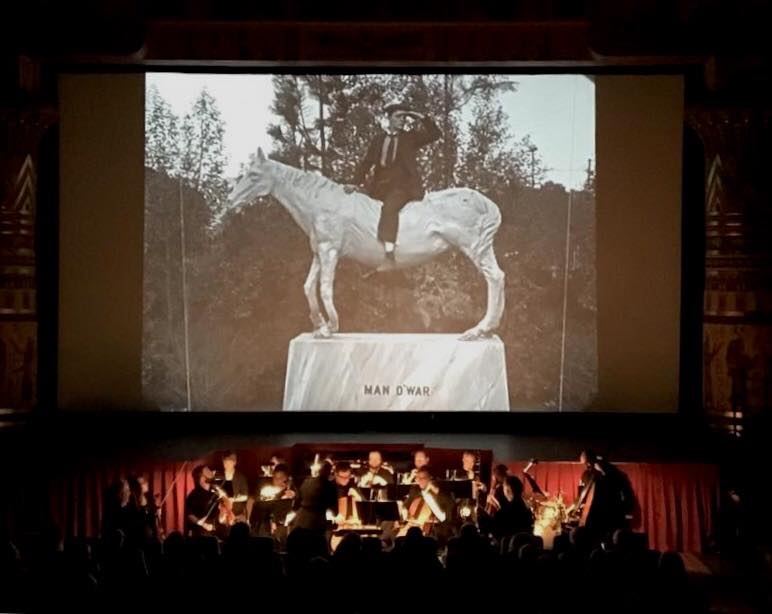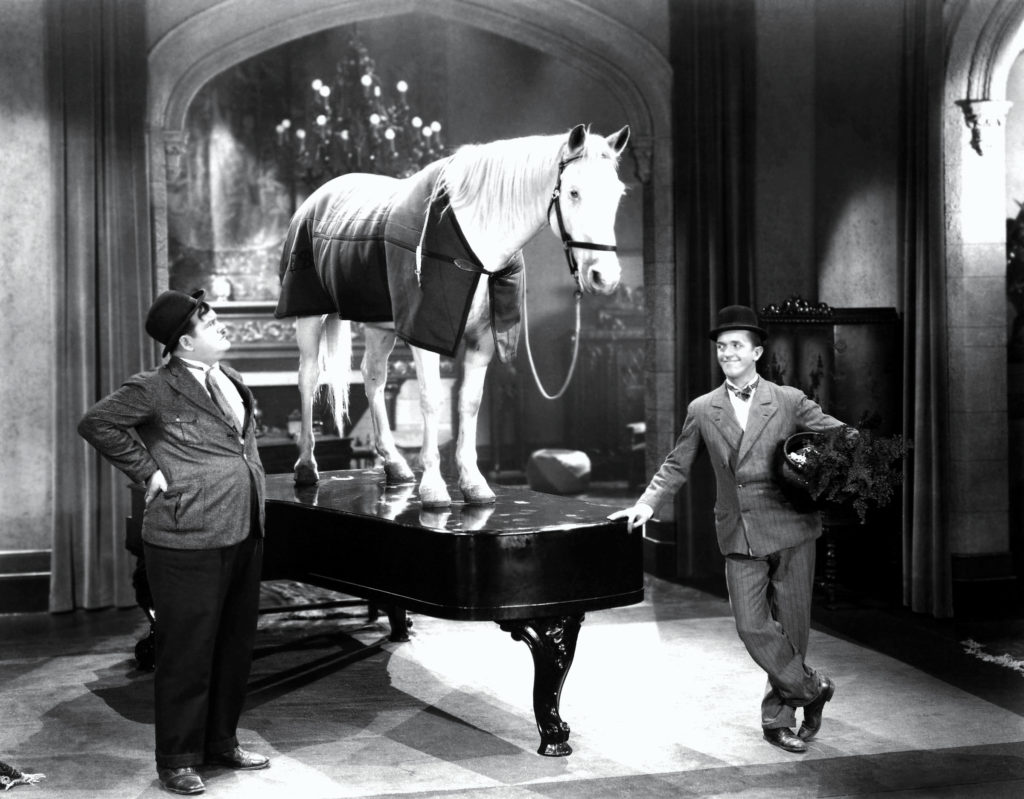
One of the most dedicated advocates for the preservation and relevancy of silent films is Ben Model , a nationally recognized composer, accompanist and film archivist. For more than three decades, Model has created and performed live scores for silent films at locations across the United States, including the Museum of Modern Art in New York and the Library of Congress, as well as on Turner Classic Movies, his own YouTube channel, and numerous DVD and Blu-ray releases, including those released by his own DVD label, Undercrank Productions.
For the past decade, Model has also composed and performed original scores for the annual Musical Movies presentation at the Egyptian Theatre. This year, he’ll accompany two silent short films on the Egyptian’s legendary organ – a restoration of “Oh! What a Day” (1918) with unsung comedian Marcel Perez, and the Harold Lloyd comedy “Number, Please?” (1919) – while the Boise Philharmonic Chamber Orchestra will perform his scores for films featuring a trio of comedy legends – “One Week” (1920), with Buster Keaton, and “Wrong Again” (1929), starring Stan Laurel and Oliver Hardy. The Philharmonic’s performance for the latter film will feature the world premiere of Model’s score.
The Boise Beat spoke to Ben Model about the upcoming event, the joys and challenges of performing silent film scores for modern audiences, and a fundraising effort to repair the Egyptian’s organ.
The Boise Beat: Give us an overview of the Musical Movies event on the 17th.
Ben Model: “Musical Movies: Silent Films with Orchestra” is an annual event presented by the Boise Philharmonic at the historic Egyptian Theatre, where we present silent films with live musical accompaniment in the two ways they were presented when the Egyptian was first opened in 1927 – namely, with orchestral accompaniment and with theater organ accompaniment. The program will feature four comedies, two of which will be accompanied by the Boise Philharmonic Chamber Ensemble, playing scores that I composed.
One of the scores, for a Laurel and Hardy comedy called “Wrong Again”, is a world premiere. The score for the Buster Keaton film, “One Week,” was also composed by me, but that was composed several years ago for the Boise Philharmonic’s youth symphony.

BB: You’ve performed at Musical Movies events at the Egyptian for a number of years.
BM: The series started in 2003, and I got involved the following year. The concerts were originally performed by what was then called the Treasure Valley Youth Symphony as a way of promoting the orchestra programs in area high schools, and switched over to being performed by the Philharmonic members in 2010. So, my scores have been performed in Boise for the past fifteen years, and I’ve been coming out for the past eleven or twelve.
BB: Can you discuss working with the Boise Philharmonic?
The real thrill and honor for me, as a composer, is getting to work with the members of the Boise Philharmonic and the different conductors every year – this time, with Eric Garcia – on these scores I’ve written. The usual way these things go is you write the piece, and it gets licensed and you send it out, and that’s it. You hear what your notation software turns it into, but that’s all, and it’s not great. My scores are booked by orchestras and bands every year all over the place, professional ones as well as colleges and high schools, but I never get to hear them in person. Getting to hear my music performed by the caliber of orchestra that the Boise Philharmonic is, in a historic space like the Egyptian, every year for as long as I’ve been doing this, is a major needle-in-a-haystack treat. Plus, the feedback I get during rehearsals and from our audiences’ reactions helps me with the scores, so they’ll work even better for everyone else. It’s a rare situation to be in for any composer, and I’m grateful to absolutely everyone involved in making these annual events happen.
BB: What do you think is the primary appeal of seeing – and hearing – live musical accompaniment to silent films?
BM: The Egyptian Theatre is a historic movie palace from 1927, so what I tell the audience every year is that we are putting them in a time machine. They are seeing silent films in the exact space that they were seen and hearing an acoustic live score just as audience did back then. And what’s really cool is that the organ at the Egyptian is the same one that was installed when the theater opened. So, they’re hearing exactly what audiences in Boise heard when the theater opened.
Silent film isn’t movies without sound – it’s really more experiential because of the live performance element. That’s a big part of the show.
BB: Can it be a challenge to attract an audience who may be only accustomed to viewing films with synchronous sound? For some, especially younger viewers, they may even be used to watching films on television or even devices.
BM: It’s only a challenge to draw people in for that first time. You have to get people past the world “silent.” But we sell out every single year, so our audiences clearly know what they’re in for. It’s not such a tough sell, especially because the audiences from the Boise area are really getting the full movie palace treatment at our event. It’s not an upright piano in a rec room – it’s a movie palace with the full symphonic sound of an orchestra or a theater organ.
Everyone who comes the first time says the same thing: “This was way more fun than I thought it was going to be.”
BB: In addition to sold-out shows, how have Boise audiences reacted to the Musical Movies events?

BM: I don’t know if there’s something about Boise that makes their reaction different, but what is unique is the fact that because we’ve been doing this for fifteen or sixteen years, there’s this pocket of people in southern Idaho who don’t need to be convinced that silent movies are a lot of fun.
We do two separate programs on Friday mornings for sixth graders, so you figure that there are 700 seats in the theater times two times how many years. So, by doing this program for schoolkids, there are there are several thousand young people in the Treasure Valley who have grown up having had that special experience. That’s why the Egyptian itself, and the organ in it, is a unique treasure. I think that there are two theatre organs in playable shape in the entire state, and the one in the Egyptian is the only one installed in an actual movie house. The other one is way up north and installed in a university chapel.
So, it’s something that’s a very specific classic film experience that people in Boise get to enjoy every year. People always say, “We’re so glad you came here – you came all the way from New York!” And I have to remind them that I can’t do this in New York City. We don’t have that sort of movie palace with a working theatre organ in it that you can do a silent movie event with both organ and orchestra. Yeah, there’s Radio City Music Hall, but they’re very busy. So, to bring 1,400 sixth graders into a movie palace and show them Buster Keaton accompanied by a theater organ – I’m thrilled to get to come and do this, because a big part of what I do is what I call “audience preservation.”
It’s the other part of film preservation that doesn’t get as much coverage. If you don’t preserve the audience, you can preserve all the film you want, but if no one wants to see it – then what?
Between the school shows and the audience for the Musical Movies concert, we have all ages attending – parents, families. It’s not just one demographic – everyone comes and has a great time.
BB: What do you get personally from performances like the Musical Movies events and the numerous other silent and vintage media projects you’re involved in, including DVDs on your Undercrank Productions label?
BM: Knowing that I’ve helped people get to see silent films and enjoy them. There was a well-known drama critic and film historian named Walter Kerr – he was a drama critic for the New York Times and wrote a book called “The Silent Clowns”. He lived in my town and showed me silent movies from his 16mm collection when I was in middle and high school, this was before DVD and even VHS, so I’m trying to pass on what I got from that experience to new audiences. In all the work I do, whether it’s shows or producing and distributing DVDs, I want people to know that this unique form of cinema is enjoyable and a lot of fun.

BB: Can you talk about the fundraising effort that’s currently underway for the organ at the Egyptian?
BM: The organ is a Robert Morgan theater pipe organ, and it’s the instrument that was installed in the theater when it opened in 1927. That, in and of itself, is pretty unique. There are a number of movie houses with theater organs in them, but to find one with its original instrument is unusual. The instrument is in need of a complete overhaul and refurbishment – it’s 90 years old and has a lot of parts that don’t work anymore.
Before and during last year’s shows, there were issues where notes were sticking or weren’t working, and every year, we don’t know what’s going to happen with the organ. There’s a theatre organ technician who was in town earlier this month, a friend and colleague of mine named Gary Phillips, who spent a week doing work on it, trying to get it in a more playable condition for our events. When he first came out to assess the organ a month or so ago, half of it was not speaking. That was a change from last February, a huge one, so the instrument’s decay continues to happen.
There is important wiring inside the console that had been chewed through by mice. The entire left side of the organ was not working, though parts of it may be back online by the time of the concert. Some work was done several years ago to pull it a little further back into shape, but over the last five years, each time I come out to play I find that a little more of it has gone out of service.
We’re now at a point where we can’t wait. If there was an endangered species list for musical instruments, the theatre organ would be right at the top, if not the only one on the list. It’s a very specific instrument that had a main use that lasted for about ten to twelve years. It was developed in the mid- to late teens specifically for motion picture accompaniment. But when sound came in, the organ was relegated to play overtures and sing-alongs, but there was no real need for it in movie theaters anymore.
The instrument in the Egyptian is a real treasure, and it needs a complete refurbishment so it can live on. Otherwise, as we’ve seen over the last few years, it will continue to decay, and eventually to a point where it may become unplayable. This has happened with many other theatre organs in the U.S. There’s a local volunteer organization called Friends of the Egyptian who have organized a campaign to raise funds to completely repair the Robert Morton theatre organ. Folks who are interested in helping out by donating or getting involved can go to www.restoretheegyptianorgan.org for more info.












Great article Paul! Can’t wait to experience this….Regards….Sterling
Comments are closed.